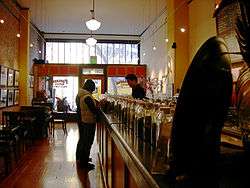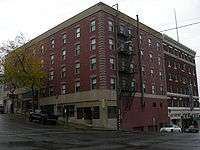Panama Hotel (Seattle)
The Panama Hotel in Seattle, Washington's International District was built in 1910. The hotel was built by the first Japanese-American architect in Seattle, Sabro Ozasa, and contains the last remaining Japanese bathhouse (sento) in the United States.[3]
Panama Hotel | |
 Coffeehouse in the old lobby of the Panama Hotel | |
| Location | 605 S. Main St Seattle, Washington |
|---|---|
| NRHP reference No. | 06000462 |
| Significant dates | |
| Added to NRHP | March 20, 2006[1] |
| Designated NHL | March 20, 2006 [2] |
The Panama Hotel was essential to the Japanese community, the building housed businesses, a bathhouse, sleeping quarters for residents and visitors, and restaurants.[4] Since 1985 the Panama Hotel has been owned by Jan Johnson. Johnson, the third owner of the Panama Hotel has restored the building to emulate its previous condition before the internment of Japanese Americans from Seattle.[5]
Johnson has closed off the basement that holds the belongings of the Japanese families to the public, and has installed a glass panel in the floorboards for visitors to view the artifacts from above.[5]
The Panama Hotel is known for the rich Japanese American history before and during World War II. The hotel is known for housing the belongings of the Japanese families in Seattle once Executive Order 9066 was enacted and the detention of Japanese in internment camps. After the Japanese American internment, most of the Seattle-based families were not able to return due to death, financial constraints, and relocation; their belongings still reside in the basement of the hotel.[4][6]
It is also known as being the namesake of the novel Hotel on the Corner of Bitter and Sweet by Jamie Ford.

Seattle's "Japantown" (Nihonmachi)
Located in the International District of Seattle, multiple districts were formed during the early 1900s based on race and ethnicity. Seattle's "Japantown" (Nihonmachi) community was established to keep races segregated, but it allowed cultural bonds to be formed.[7]
Japanese immigrants from all the regions of Japan came to Seattle and became interconnected because of the Nihonmachi.[8] Even though the Japanese people of Japantown faced poverty due to economic hardships, skilled workers in all different industries came together because of the immigration from different prefectures in Japan.[9]
Japanese Bathhouses (Sento)
The Panama Hotel was one of the focal points in Japantown before World War II. The hotel was known for the Hashidate-Yu, one of the four bathhouses (Sento) in Seattle during the early twentieth-century.[10] Separated into two areas, one for men and the other for women and children, these bathhouses were essential in the Japantown because most of the residents did not have access to facilities in their residences. The bathhouses allowed people to interact with one another and spread their culture with the locals or visitors from other countries.[11]
National Landmark
It was declared a National Historic Landmark building in 2006, and on April 9, 2015, the Panama Hotel was designated a National Treasure by the National Trust For Historic Preservation - one of only 60 in the United States.[2][12]

The Panama Hotel Film
The Panama Hotel Legacy is a film currently in production that will explore the unique history of the 105 year-old property and the continuous stewardship to preserve its history and educate current and future generations.
The film will detail the building's influence in place, culture and community, the ongoing preservation efforts for the Panama Hotel including the Hashidate Yu Sento, one of the most well-preserved bathhouses in the U.S. and the archiving of Japanese Americans' belongings stored in the hotel as a result of Executive Order 9066 issued by President Roosevelt in 1942.
References
- "National Register Information System". National Register of Historic Places. National Park Service. January 23, 2007.
- "Panama Hotel". National Historic Landmark summary listing. National Park Service. 2007-09-17. Archived from the original on 2008-01-30. Retrieved 2007-09-18.
- Alanen 2000, p. 166
- Kaplan, Melanie. "The Mysteries of the Panama Hotel". ProQuest 1754821799. Cite journal requires
|journal=(help) - Brown, Kate. "The Eclipse of History: Japanese America and a Treasure of Forgetting". doi:10.1215/08992363-9-1-69. Cite journal requires
|journal=(help) - "Seattle's Panama Hotel deemed a National Treasure". The Seattle Times. 2015-07-26. Retrieved 2016-05-16.
- Brown, Kate (2015). Dispatches from Dystopia. Chicago: The University of Chicago Press. ISBN 978-0-226-24279-8.
- Murayama, Yuzo (1991-01-01). "Information and Emigrants: Interprefectural Differences of Japanese Emigration to the Pacific Northwest, 1880-1915". The Journal of Economic History. 51 (1): 125–147. doi:10.1017/S0022050700038390. JSTOR 2123054.
- Murayama, Yuzo (1991-01-01). "Information and Emigrants: Interprefectural Differences of Japanese Emigration to the Pacific Northwest, 1880-1915". The Journal of Economic History. 51 (1): 125–147. doi:10.1017/S0022050700038390. JSTOR 2123054.
- "The Panama Hotel opens in Seattle's Japantown in the summer of 1910". www.historylink.org. Retrieved 2016-05-20.
- "The Panama Hotel opens in Seattle's Japantown in the summer of 1910". www.historylink.org. Retrieved 2016-05-20.
- Note: A National Register of Historic Places Inventory-Nomination document should be available upon request from the National Park Service for this site, but it appears not to be available on-line from the NPS Focus search site.
External links
- Official website, with history and photographs
- Gross, Ashley (2016-01-13). "Seattle's Panama Hotel, Known For Its Japanese-American History, Is Up For Sale". KPLU.org. Tacoma / Seattle, WA, US: KPLU-FM. Retrieved 2016-01-13.
- Official website for The Panama Hotel Legacy Film Project, with a preview of the film
Sources
| Wikimedia Commons has media related to Panama Hotel (Seattle). |
- Alanen, Arnold Robert; Melnick, Robert (2000). Preserving Cultural Landscapes in America, JHU Press, ISBN 0-8018-6264-7.

